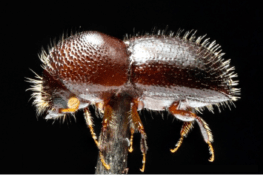Tree breeding and sustainable intensification (planting more productive trees on less land) are actively being practised in South Africa. (Mondi South Africa)
The polyphagous shot hole borer beetle (PSHB) is dark brown, roughly the size of a sesame seed and probably hitchhiked its way into South Africa in shipped wood from its native Southeast Asia.
The large number of plants it can occupy, its small size and its association with a pathogenic fungus makes it arguably the worst invasive insect that South Africa has had to deal with, according to Ruan Veldtman, of the South African National Biodiversity Institute.

The beetle is only 2mm long.
(Garden Route Botanical Garden)
The beetle bores tunnels into a tree and spreads a fungus that blocks a tree’s vascular tissue, which eventually kills the plant. It has been found in at least 130 different types of trees, including indigenous species such as the Cape beech and keurboom and has led to the loss of thousands of trees, especially in the garden cities of Joburg, Cape Town and Stellenbosch.
There’s a search for biological control agents in China and Vietnam, which can hopefully be used to eradicate the beetle in South Africa too.
“These control agents could be anything from a parasitoid wasp that attacks the beetle’s eggs and larvae to a fungus that infects adult beetles. Once a control agent is found, it isn’t just released. Rigorous testing is done to ensure it will only kill the invasive species and not our native ones,” says Garyn Townsend, a PhD student working with the Centre for Biological Control.
How to check your trees
The beetle is very small, so you’re unlikely to see it. But you should inspect your trees regularly for these signs, according to Greenpop:
- Wilting trees and dead branches’;
- Exit or entry holes on the bark of the trees;
- Shotgun-like lesions and blotches of oozing resin on the bark; and
- Wooden powder at entry or exit holes.
Infected trees will probably have to be cut down and disposed of through burning. If you suspect your tree has been infected, contact [email protected] for advice on what steps to take.
This is an edited version of the article first published by Treevolution. Subscribe to their newsletter here.